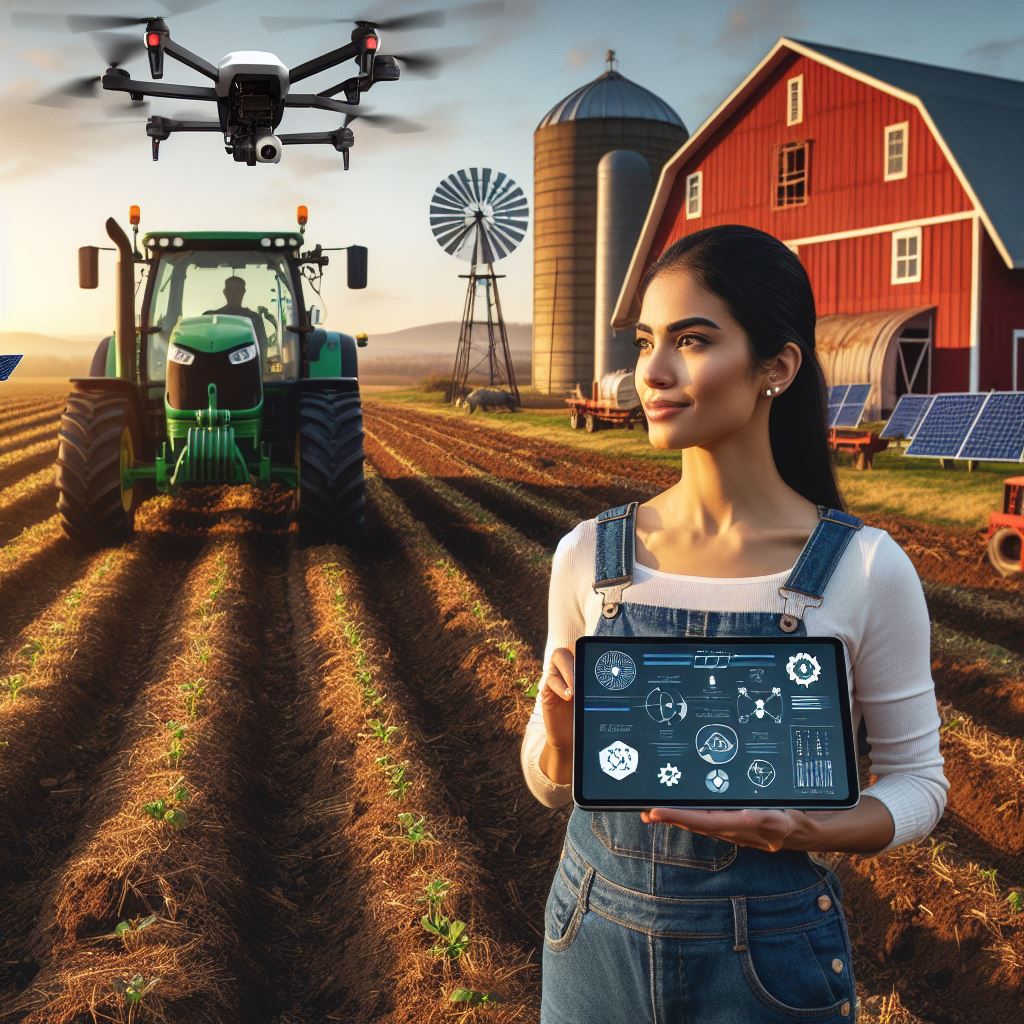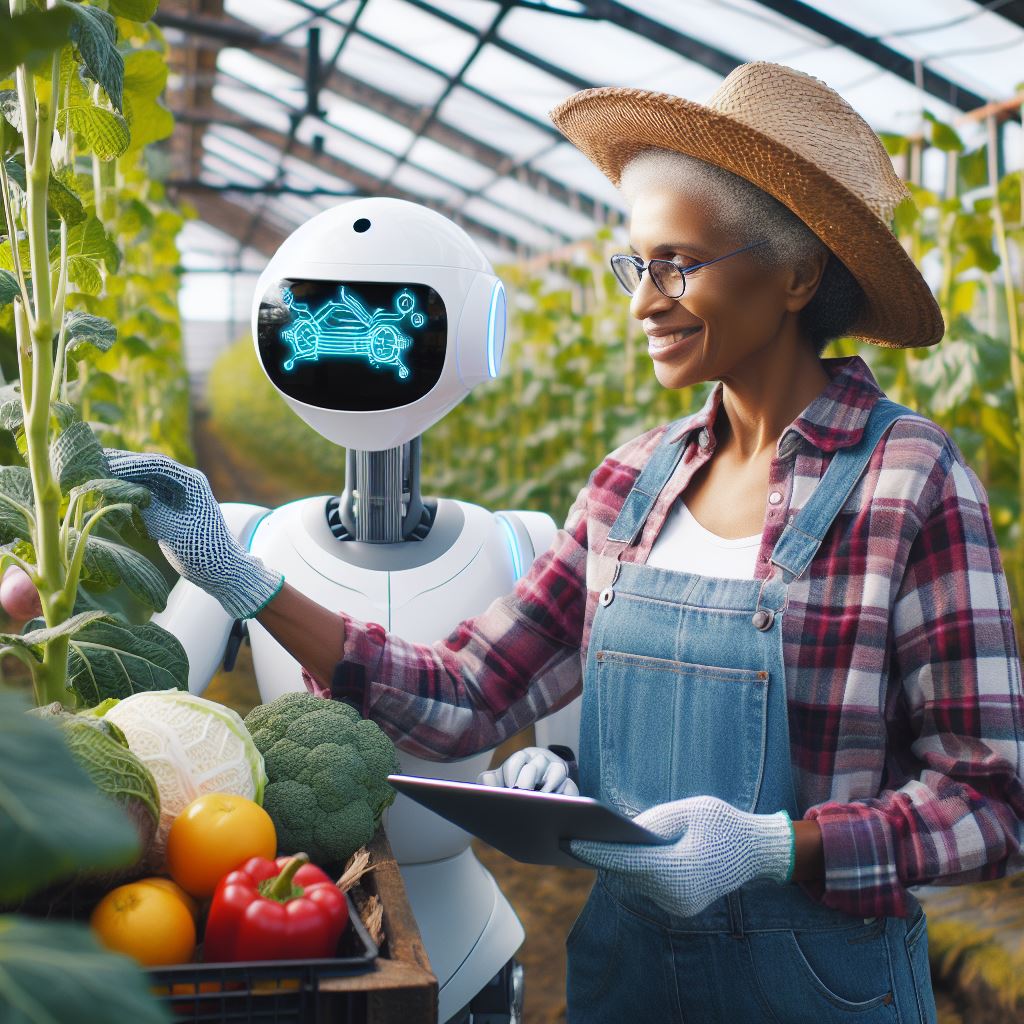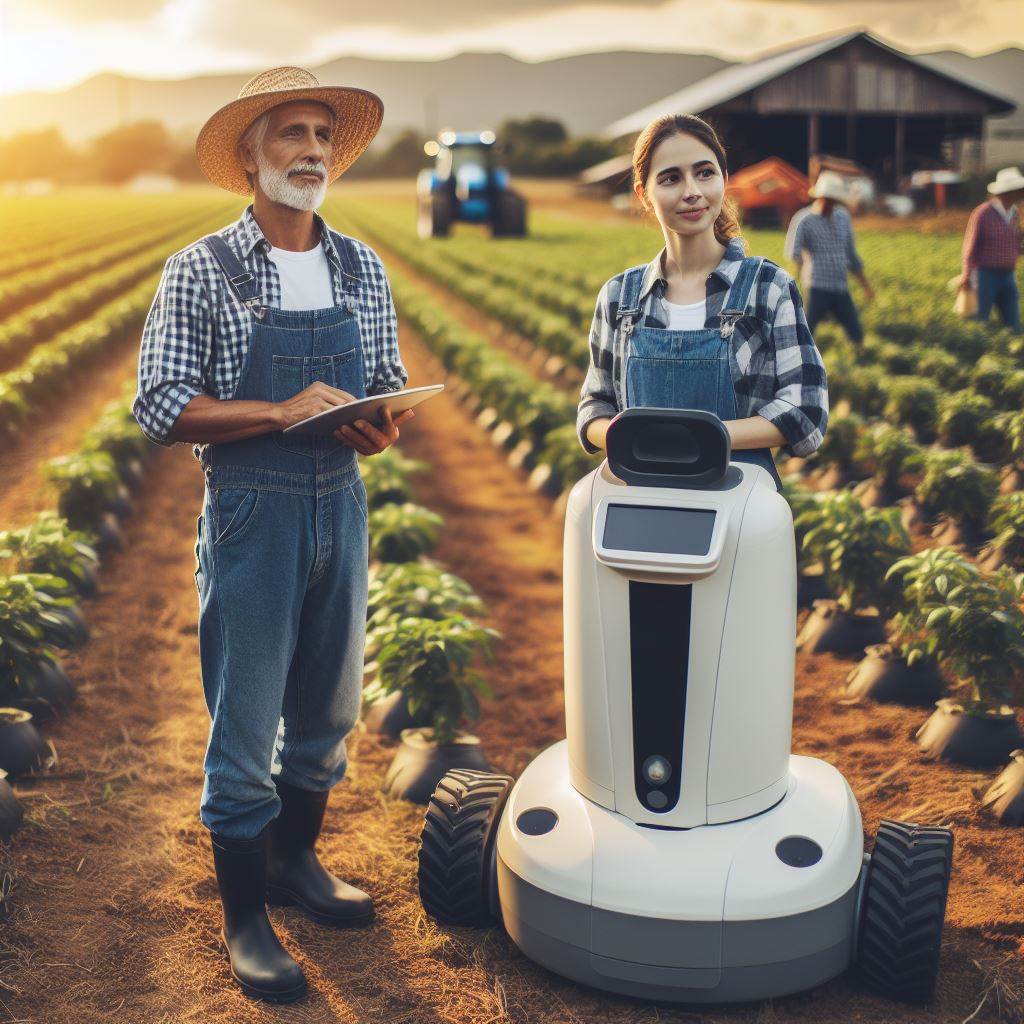Introduction
Automation and its impact on various industries
Automation has had a significant impact on various industries, including the agricultural sector.
This blog post will explore the importance of automation in agriculture and provide an overview of the content to follow.
As technology continues to advance, automation has become a vital tool for enhancing productivity and efficiency.
In agriculture, automation offers numerous benefits, such as increased yield, reduced labor costs, and improved crop quality.
Importance of automation in agriculture
Through the use of robotics and smart farming techniques, farmers can automate various tasks, such as planting, irrigation, and harvesting.
This allows them to optimize resource allocation and streamline operations.
Automation also enables farmers to monitor their crops and livestock more effectively.
With the help of sensors and data analytics, they can gather real-time information on soil moisture, temperature, and crop health.
This data allows them to make data-driven decisions, prevent potential issues, and maximize yields.
Furthermore, automation minimizes human error and reduces the reliance on manual labor.
By utilizing autonomous machinery, farmers can eliminate repetitive and labor-intensive tasks, improving overall productivity and reducing workplace injuries.
Overview of the blog post content
In this blog post, we will delve into the specific applications of automation in agriculture, including precision farming, drone technology, and robotic harvesting.
We will also discuss the challenges and future prospects of implementing automation in this industry.
Overall, automation is revolutionizing the agricultural sector, offering sustainable solutions to meet the demands of a growing population.
This blog post aims to provide insights into the transformative power of automation in agriculture and its potential to reshape the future of food production.
Transform Your Agribusiness
Unlock your farm's potential with expert advice tailored to your needs. Get actionable steps that drive real results.
Get StartedBenefits of automation in agriculture
Automation has revolutionized several industries, including agriculture.
The integration of technology and robotics has transformed farming practices, resulting in numerous benefits and advancements.
In this section, we will explore the various advantages of automation in agriculture.
Increased Efficiency and Productivity
By automating repetitive tasks, such as planting, harvesting, and irrigation, farmers can significantly increase their overall efficiency and productivity.
Automated machinery can work continuously, eliminating the need for breaks, resulting in faster completion of tasks.
Reduction in Manual Labor
Automation reduces the reliance on manual labor, which can be physically demanding and time-consuming.
With machines taking over labor-intensive tasks, farmers can allocate their workforce to more skilled and specialized activities.
Improved Accuracy and Precision in Farming Processes
Automated systems are designed to operate with precision, ensuring accurate and consistent farming techniques.
This level of precision reduces human errors and ensures that crops receive optimal conditions for growth and development.
Enhanced Crop Quality and Yield
Automation allows farmers to monitor and control various parameters related to crop growth, such as temperature, humidity, and nutrients.
This level of control results in healthier plants, better crop quality, and ultimately higher yields.
Cost Savings and Economic Advantages
While initial investment costs for automation technology can be high, they are offset by long-term cost savings.
Automated systems can optimize resource utilization, reduce waste, and minimize the need for manual labor, resulting in increased profitability for farmers.
Furthermore, automation enables farmers to scale up their operations without a proportional increase in labor costs.
This scalability helps meet the growing demand for agricultural products without compromising efficiency or incurring significant expenses.
Contributes to sustainability
In addition to these benefits, automation in agriculture also contributes to sustainability.
Automated irrigation systems, for example, can precisely deliver water, minimizing wastage and conserving this valuable resource.
Similarly, automated machinery can reduce the use of chemical pesticides by targeting specific areas more accurately.
It is essential to note that while automation offers several advantages, it is not meant to replace human intervention altogether.
Farmers and agricultural workers still play a crucial role in overseeing operations, making informed decisions, and adapting to changing conditions.
Essentially, automation in agriculture has transformed traditional farming practices, providing numerous benefits.
Increased efficiency, reduced manual labor, improved accuracy, and enhanced crop quality are some of the advantages that contribute to the overall success and economic well-being of farmers.
With continuous advancements in technology, the future of farming looks promising, paving the way for a more sustainable and productive agricultural industry.
Read: Automation in Agriculture: Pros & Cons
Showcase Your Farming Business
Publish your professional farming services profile on our blog for a one-time fee of $200 and reach a dedicated audience of farmers and agribusiness owners.
Publish Your ProfileApplications of Automation in Agriculture
Automation has revolutionized various industries, and agriculture is no exception.
With the advancement in technology, automated machinery, precision farming techniques, robotics, drones, sensor technology, artificial intelligence, and machine learning have become integral parts of modern farming operations.
Let’s delve into these applications in detail:
Automated Machinery and Equipment
- Farmers now rely on automated machinery for tasks such as planting, harvesting, irrigation, and pesticide application.
- These machines not only increase efficiency but also reduce physical labor required by farmers.
- Tractors with GPS systems enable accurate field mapping and precise operation control.
- Combine harvesters automatically adjust settings based on crop conditions, optimizing the harvesting process.
Precision Farming Techniques
- Automation enables precision farming techniques, ensuring maximum crop productivity while minimizing inputs.
- Soil sensors analyze moisture levels, nutrient content, and temperature, aiding in precise irrigation and fertilization.
- Automated systems adjust planting density, seed spacing, and release appropriate amounts of chemicals based on real-time data analysis.
- GPS-guided equipment and variable-rate technology help farmers optimize resource use, leading to cost savings and environmental benefits.
Robotics and Drones in Farming Operations
- Robots are increasingly used for planting, weeding, spraying pesticides, and even milking cows.
- These autonomous machines operate efficiently and accurately, reducing manual labor and enhancing productivity.
- Drones equipped with cameras, sensors, and GPS technology can monitor crops, identify pests, and detect crop diseases.
- Such aerial surveillance helps farmers take timely actions to prevent damage and improve overall crop health.
Sensor Technology for Monitoring and Data Collection
- Sensors placed throughout the farm collect data on soil moisture, temperature, humidity, and atmospheric conditions.
- Monitoring these parameters helps farmers optimize irrigation, determine optimal plant growth conditions, and forecast weather-related risks.
- Sensors can also detect threats like fire, gas leaks, or equipment malfunctions, ensuring timely intervention and preventing losses.
- Real-time data collection enables farmers to make informed decisions and take preventive measures promptly.
Artificial Intelligence and Machine Learning in Decision-Making
- Artificial intelligence and machine learning algorithms analyze vast amounts of data, providing valuable insights for decision-making.
- These technologies can predict yield, disease outbreaks, determine optimal planting schedules, and recommend suitable crop varieties.
- Machine learning helps optimize resource allocation, crop rotation plans, and pest management strategies.
- Automated systems powered by AI can also control climate conditions in greenhouses for optimal crop growth.
The applications of automation in agriculture have transformed the way farmers approach farming activities.
By embracing technology, farmers can increase efficiency, reduce labor, optimize resource use, and improve overall crop health.
With further advancements, automation will continue to revolutionize agriculture, making it more sustainable, productive, and economically viable.
Read: Predictive Analytics in Agriculture
Challenges and Limitations of Automation in Agriculture
As automation continues to revolutionize various industries, the field of agriculture is no exception.
With the introduction of advanced technologies such as robots, drones, and smart machinery, the potential benefits of automation in agriculture are vast.
However, alongside its advantages, there are also numerous challenges and limitations that must be addressed.
High Initial Investment Costs
- The implementation of automation in agriculture often requires significant financial resources.
- Purchasing high-tech equipment and machinery can pose a barrier to entry for many farmers.
- The initial investment costs can be particularly burdensome for small-scale farmers.
Limited Accessibility for Small-Scale Farmers
- Automation technologies may not be easily accessible to small-scale farmers due to cost limitations.
- The lack of affordability and availability of automation tools can hinder the adoption process.
- Small-scale farmers may struggle to compete with larger agricultural enterprises that can afford automation.
Potential Job Displacements
- Automation in agriculture has the potential to replace human labor, leading to job displacements.
- Tasks that were traditionally performed by farm workers may now be executed by robots or machines.
- This could have significant socioeconomic implications, particularly in rural farming communities.
Technical and Compatibility Issues
- Implementing automation in agriculture often requires integrating multiple technologies.
- Incompatibility between different systems can lead to technical challenges and inefficiencies.
- Ensuring seamless communication and compatibility between various automated components is crucial.
Environmental Concerns and Sustainable Practices
- While automation offers potential benefits, it also raises environmental concerns.
- Increased energy consumption and reliance on non-renewable resources can negatively impact sustainability.
- Efforts must be made to develop and implement automation technologies that align with sustainable practices.
In general, while automation presents significant opportunities for enhancing productivity and efficiency in agriculture, there are several challenges and limitations that need to be addressed.
The high initial investment costs, limited accessibility for small-scale farmers, potential job displacements, technical and compatibility issues, and environmental concerns all pose obstacles to the widespread adoption of automation in agriculture.
It is crucial to find sustainable solutions and ensure that automation benefits all farmers, regardless of their scale of operations.
Read: AI in Farming: Boosting Yields Smartly

Uncover the Details: Soil Health: AI and Sensor Revolution
Success stories of automation in agriculture
Case studies of farms implementing automation
- Johnson Farms: By implementing automated irrigation systems, they reduced water usage by 30% and increased crop yield by 20%.
- Green Acres Dairy: Adopting robotic milking machines improved milk production capacity by 25% and reduced labor costs by 40%.
Positive outcomes and lessons learned
- Increased Efficiency: Automation streamlines processes, reducing the time and effort required for various tasks.
- Enhanced Quality: Automated sorting systems ensure consistent product standards, meeting consumer expectations.
- Workforce Optimization: Automation allows farmers to utilize their workforce more strategically, focusing on higher-value activities.
- Data-Driven Decision Making: Automation provides farmers with real-time data and analytics for better operational decisions.
Examples of increased profitability and sustainability
- Cost Savings: Automation decreases labor costs and minimizes waste by optimizing resource utilization.
- Improved Crop Yield: Precise planting and fertilizing techniques through automation result in higher yields and improved profitability.
- Reduced Environmental Impact: Automation enables the precise application of fertilizers and pesticides, minimizing runoff and pollution.
- Enhanced Food Safety: Automation ensures stringent quality control measures, reducing the risk of contamination and foodborne illnesses.
Innovation in Automation
- Automated Harvesting: Robotic arms equipped with computer vision technology enable efficient and precise fruit and vegetable picking.
- Drone Technology: Drones equipped with sensors and cameras assist in crop monitoring, disease detection, and yield prediction.
- Autonomous Vehicles: Self-driving tractors and harvesters optimize farming operations, reducing manual labor and improving efficiency.
- Smart Irrigation: Sensors and automated irrigation systems adjust water usage based on real-time weather conditions and plant needs.
Challenges and Future Directions
- Cost of Implementation: High upfront costs hinder small-scale farmers from adopting automation technologies.
- Skilled Workforce: The need for personnel with expertise in technology and automation poses a challenge.
- Integration of Systems: Ensuring compatibility and seamless integration among different automated systems can be complex.
- Ethical Concerns: Balancing the use of automation with the preservation of traditional farming practices and rural communities.
In essence, automation in agriculture has proven to be highly beneficial, with success stories showcasing increased profitability, sustainability, and improved farming practices.
Case studies demonstrate the positive impact of automation on various farms, yielding higher crop yields, minimized costs, and enhanced food safety.
Lessons learned emphasize the increased efficiency, quality, and data-driven decision making facilitated by automation technologies.
As innovation continues, automated harvesting, drone technology, autonomous vehicles, and smart irrigation systems pave the way for a more productive and sustainable agriculture industry.
However, challenges such as implementation costs, skilled workforce availability, system integration, and ethical concerns need to be addressed for widespread adoption.
Despite these hurdles, automation remains a transformative force in reshaping agriculture and driving it towards a more technologically advanced and efficient future.
Read: Innovative Farming: Using AI for Water Management
Future prospects of automation in agriculture
Technological advancements and ongoing innovations
- Technological advancements and ongoing innovations have opened up new possibilities for automation in the agricultural sector.
- There is great potential for further integration of automation in farming, allowing for increased efficiency and productivity.
- The role of research and development cannot be underestimated in shaping the future of automation in agriculture.
- Continuous advancements in technology and farming practices will drive the evolution of automation in the agricultural sector.
- Automation has the potential to revolutionize the way we cultivate crops, manage livestock, and optimize resource utilization.
- The use of robotics and drones in farming operations is expected to increase, providing more precise and efficient solutions.
- Automation can help farmers reduce labor-intensive tasks, optimize crop rotation, and improve overall farming practices.
- By utilizing automation in agriculture, farmers can monitor and analyze data, enabling them to make data-driven decisions for better outcomes.
Predictions for the impact of automation on agriculture
- Increased automation in agriculture is expected to lead to higher yields and improved quality of crops.
- Automation will enable farms to operate with fewer workers, reducing labor costs and increasing overall profitability.
- Farmers will embrace automation to overcome labor shortages and the challenges posed by unpredictable weather conditions.
- Automation can help address environmental concerns by enabling better monitoring and management of resources.
- By streamlining processes and reducing manual errors, automation can enhance the safety and well-being of farm workers.
- Automation can lead to more sustainable farming practices by optimizing the use of water, fertilizers, and pesticides.
- With automation, farmers can access real-time data and implement timely interventions to prevent crop diseases and pest infestations.
- The integration of automation and artificial intelligence can enable predictive analytics for better farm management and decision-making.
- Automation can create new job opportunities in the agricultural sector, such as technicians and data analysts specialized in agricultural technologies.
- The successful implementation of automation in agriculture will require education and training programs to equip farmers with the necessary skills.
Technological advancements and ongoing innovations
The future of agriculture lies in embracing automation as a means to address the challenges faced by the sector.
Technological advancements and ongoing innovations offer tremendous potential for the integration and expansion of automation in farming operations.
Research and development play a crucial role in shaping the future, as continuous improvements in technology and farming practices will drive the evolution of automation in agriculture.
Predictions for the impact of automation on agriculture
With automation, farmers can increase efficiency, productivity, and profitability while reducing labor costs and addressing labor shortages.
Moreover, automation can help overcome environmental concerns by optimizing resource utilization and implementing sustainable farming practices.
By utilizing real-time data and predictive analytics, farmers can make data-driven decisions, ensuring better crop yields and quality.
The integration of automation and artificial intelligence will further enhance farm management and decision-making processes.
Investment in education and training programs
However, the successful implementation of automation in agriculture requires investment in education and training programs.
Farmers need to acquire the necessary skills to operate and manage automated farming systems effectively.
The agricultural sector should also collaborate with technology companies, researchers, and governments to ensure the development and availability of advanced automation technologies tailored to the specific needs of agriculture.
The future of automation in agriculture is promising.
It has the potential to transform the way we produce food, making farming operations more efficient, sustainable, and resilient.
By embracing automation, farmers can overcome challenges and ensure a prosperous future for the agricultural sector.
Gain More Insights: Yield Boosting: Robotics in Action
Conclusion
To recap, the benefits of automation in agriculture are numerous.
It can increase efficiency, reduce labor costs, and improve crop quality.
However, there are also challenges such as high initial investment and potential job displacement.
Despite these challenges, it is essential for farmers to explore automation options.
Showcase Your Farming Business
Publish your professional farming services profile on our blog for a one-time fee of $200 and reach a dedicated audience of farmers and agribusiness owners.
Publish Your ProfileBy embracing technology, they can stay competitive and meet the growing demands of a rapidly changing industry.
In a nutshell, the transformative potential of automation in agriculture cannot be underestimated.
It has the power to revolutionize farming practices and contribute to a more sustainable and productive future.
As we witness success stories from early adopters, it becomes clear that automation is the way forward.
So, let us encourage farmers to embrace automation and equip themselves with the necessary knowledge and resources to integrate it into their operations.
By doing so, they can unlock the full potential of technology and thrive in the ever-evolving agricultural landscape.




